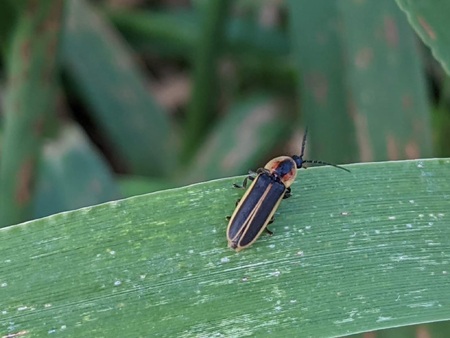
Good Natured: The Firefly
Enchanting. Enthralling. Captivating. Delightful. These are just a few of the superlatives I've come across as while gathering material for this week's column.
Offhand I can think of only a few things that merit such across-the-board praise: Chocolate fountains (delightful, for sure, but not very nature-y). Puppies (captivating on every level, but best praised elsewhere). And, finally, fireflies—those radiant insects synonymous with our summer nights.
As one of the few creatures in our area that are truly bioluminescent—that is, able to make their own light—fireflies a.k.a. lightning bugs have fascinated generations of kids and adults alike. Even people who don't identify as nature nerds can recognize and even appreciate the light displays of the family Lampyridae.
But you know what? As familiar as they are in their adult stage, fireflies actually start out life in relative obscurity.
If we were to turn back time a few months to, let's say, April, the flashy insects we know so well were still in their larval stage. Living under rocks and logs, they glowed faintly but continuously as they went about their business of hunting prey.
That's right! Our beloved lightning bugs, whose gentle habits have captivated humans for generations, start out life as predacious larvae, consuming earthworms, other insect larvae and anything else they can sink their mandibles into.
Taxonomically speaking, fireflies are Coleopterans—beetles to the rest of us—so they go through four life stages: egg, larva, pupa and adult. The first three account for the majority of an individual lightning bug's life. An egg takes about four weeks to hatch, then the larva feeds and grows over a period of one to two years. Pupation, that remarkable transformation from flightless larva to flighted, and lighted, adult, takes about a month.
Once mature, fireflies have only a few short weeks left to live. Their primary aim at this point is to find a mate and make sure their genes get passed on to the next generation…which is where the “fire" in firefly and the “lightning" in lightning bugs comes in. As dusk sets in, determined male lightning bugs take to the air, flashing their flamboyant displays and hoping to catch the eye of an available female.
Meanwhile, on a convenient perch like a twig or blade of grass, the females wait and watch. Should one see a male with an aerial exhibition she finds appealing, she'll flash back in a species-appropriate way. Seeing this favorable response, the chosen male will make a beeline (or I suppose more correctly a beetle-line) down to meet his intended.
Neither rain nor heat nor gloom of night will stay this courier from his self-appointed rounds. In fact, the warmer and more humid the evening, the better, as far as the fireflies are concerned. If the female continues to respond, the male will continue his pursuit, and the flashy courtship will go on, sometimes for an hour or more.
If all goes well, mating occurs and both parties depart, she to begin the process of depositing eggs, he to find another partner, and both presumably live happily ever after. But even for fireflies, there are no guarantees.
When a human relationship goes south, the male sometimes loses his shirt. When a firefly relationship hits the skids, the male often loses his head.
In the firefly world, danger exists in the form of femmes fatales, large females of the genus Photuris that prey upon the smaller males of the genus Photinus. These sly sirens mimic the flash responses of the other species' females to lure in their unsuspecting victims. As the male approaches what he believes is a potential partner, he meets instead with an impassioned impostor, who promptly tears him limb from limb.
Scientists believe femmes fatales act the way they do to not only increase their nutrient intake, but also to make themselves less palatable to predators. Photinus species contain defensive steroids called lucibufagins that Photuris species do not. By consuming male Photinus, female Photuris acquire those steroidal compounds and thus become distasteful to predators like spiders and birds.
After Photuris females have eaten their fill, they switch their flash patterns to that of their own species, and mating behaviors proceed in a more predictable course.
It's not hard to observe this and many other firefly feats, in yards, parks and preserves throughout our area. Just head outside as the sun is setting and keep your eyes peeled for the following:
- Photinus pyralis, our most common firefly; emits J- or U-shaped arc of greenish-yellow light
- Photinus marginellus, a tiny firefly that is a frequent target for Photuris females; prefers forest edges; emits small dots of light
- Photuris lucicrescens, our largest species; hovers in one spot and emits light in a crescendo
The Fourth of July always coincides with peak firefly mating season, so the individuals of these species—that is, those that survived our drought conditions—should now be out in force. Enjoy their enchanting light show while you can though; it lasts for only a few weeks before ending…in a brief but enthralling flash.
Pam Otto is the outreach ambassador for the St. Charles Park District. She can be reached at potto@stcparks.org.

